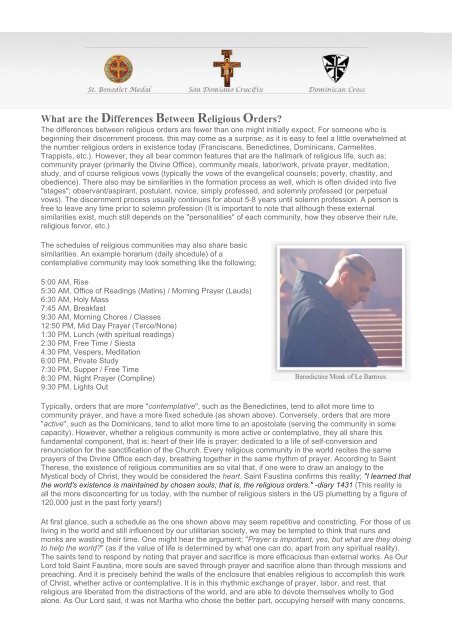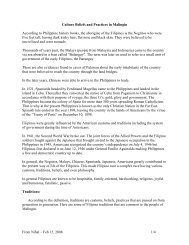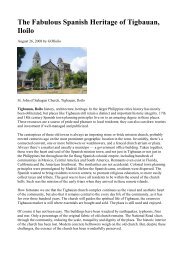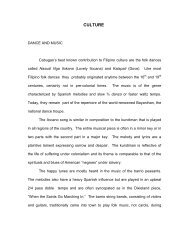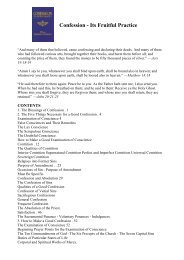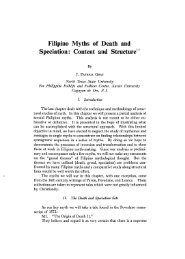What are the Differences Between Religious Orders?
What are the Differences Between Religious Orders?
What are the Differences Between Religious Orders?
- No tags were found...
Create successful ePaper yourself
Turn your PDF publications into a flip-book with our unique Google optimized e-Paper software.
<strong>What</strong> <strong>are</strong> <strong>the</strong> <strong>Differences</strong> <strong>Between</strong> <strong>Religious</strong> <strong>Orders</strong>?The differences between religious orders <strong>are</strong> fewer than one might initially expect. For someone who isbeginning <strong>the</strong>ir discernment process, this may come as a surprise, as it is easy to feel a little overwhelmed at<strong>the</strong> number religious orders in existence today (Franciscans, Benedictines, Dominicans, Carmelites,Trappists, etc.). However, <strong>the</strong>y all bear common features that <strong>are</strong> <strong>the</strong> hallmark of religious life, such as;community prayer (primarily <strong>the</strong> Divine Office), community meals, labor/work, private prayer, meditation,study, and of course religious vows (typically <strong>the</strong> vows of <strong>the</strong> evangelical counsels; poverty, chastity, andobedience). There also may be similarities in <strong>the</strong> formation process as well, which is often divided into five"stages"; observant/aspirant, postulant, novice, simply professed, and solemnly professed (or perpetualvows). The discernment process usually continues for about 5-8 years until solemn profession. A person isfree to leave any time prior to solemn profession (It is important to note that although <strong>the</strong>se externalsimilarities exist, much still depends on <strong>the</strong> "personalities" of each community, how <strong>the</strong>y observe <strong>the</strong>ir rule,religious fervor, etc.)The schedules of religious communities may also sh<strong>are</strong> basicsimilarities. An example horarium (daily shcedule) of acontemplative community may look something like <strong>the</strong> following;5:00 AM, Rise5:30 AM, Office of Readings (Matins) / Morning Prayer (Lauds)6:30 AM, Holy Mass7:45 AM, Breakfast9:30 AM, Morning Chores / Classes12:50 PM, Mid Day Prayer (Terce/None)1:30 PM, Lunch (with spiritual readings)2:30 PM, Free Time / Siesta4:30 PM, Vespers, Meditation6:00 PM, Private Study7:30 PM, Supper / Free Time8:30 PM, Night Prayer (Compline)9:30 PM, Lights OutTypically, orders that <strong>are</strong> more "contemplative", such as <strong>the</strong> Benedictines, tend to allot more time tocommunity prayer, and have a more fixed schedule (as shown above). Conversely, orders that <strong>are</strong> more"active", such as <strong>the</strong> Dominicans, tend to allot more time to an apostolate (serving <strong>the</strong> community in somecapacity). However, whe<strong>the</strong>r a religious community is more active or contemplative, <strong>the</strong>y all sh<strong>are</strong> thisfundamental component, that is; heart of <strong>the</strong>ir life is prayer; dedicated to a life of self-conversion andrenunciation for <strong>the</strong> sanctification of <strong>the</strong> Church. Every religious community in <strong>the</strong> world recites <strong>the</strong> sameprayers of <strong>the</strong> Divine Office each day, breathing toge<strong>the</strong>r in <strong>the</strong> same rhythm of prayer. According to SaintTherese, <strong>the</strong> existence of religious communities <strong>are</strong> so vital that, if one were to draw an analogy to <strong>the</strong>Mystical body of Christ, <strong>the</strong>y would be considered <strong>the</strong> heart. Saint Faustina confirms this reality; "I learned that<strong>the</strong> world's existence is maintained by chosen souls; that is, <strong>the</strong> religious orders." -diary 1431 (This reality isall <strong>the</strong> more disconcerting for us today, with <strong>the</strong> number of religious sisters in <strong>the</strong> US plumetting by a figure of120,000 just in <strong>the</strong> past forty years!)At first glance, such a schedule as <strong>the</strong> one shown above may seem repetitive and constricting. For those of usliving in <strong>the</strong> world and still influenced by our utilitarian society, we may be tempted to think that nuns andmonks <strong>are</strong> wasting <strong>the</strong>ir time. One might hear <strong>the</strong> argument; "Prayer is important, yes, but what <strong>are</strong> <strong>the</strong>y doingto help <strong>the</strong> world?" (as if <strong>the</strong> value of life is determined by what one can do, apart from any spiritual reality).The saints tend to respond by noting that prayer and sacrifice is more efficacious than external works. As OurLord told Saint Faustina, more souls <strong>are</strong> saved through prayer and sacrifice alone than through missions andpreaching. And it is precisely behind <strong>the</strong> walls of <strong>the</strong> enclosure that enables religious to accomplish this workof Christ, whe<strong>the</strong>r active or contemplative. It is in this rhythmic exchange of prayer, labor, and rest, thatreligious <strong>are</strong> liberated from <strong>the</strong> distractions of <strong>the</strong> world, and <strong>are</strong> able to devote <strong>the</strong>mselves wholly to Godalone. As Our Lord said, it was not Martha who chose <strong>the</strong> better part, occupying herself with many concerns,
ut Mary, sitting at <strong>the</strong> feet of her Jesus, lost in His gaze (Lk 10:42). This is <strong>the</strong> life of chosen souls, of alter-Magdalene's, always looking up in <strong>the</strong> gaze of Our Lord, adoring Him in <strong>the</strong> silence and solitude of <strong>the</strong> heart,and ready to die to self-love by degrees through <strong>the</strong> vow of obedience and a thousand small sacrifices for <strong>the</strong>salvation of souls. In this sense <strong>the</strong> schedule itself is a perpetual sacrifice of great merit, since <strong>the</strong> religious isbound to it by <strong>the</strong> vow of obedience, and cannot deviate from it unless given permission do to so. Sacrifice is,by design, inherent in <strong>the</strong> life of a religious, who unbeknownst to her, may live her life without ever seeing <strong>the</strong>fruits of her merits, or <strong>the</strong> countless souls she saves.Saint Faustina, diary, 1933, .61: "O life so dull and monotonous, how many treasures you contain! When Ilook at everything with <strong>the</strong> eyes of faith, no two hours <strong>are</strong> alike, and <strong>the</strong> dullness and monotony disappear.The grace which is given me in this hour will not be repeated in <strong>the</strong> next. It may be given me again, but it willnot be <strong>the</strong> same grace. Time goes on, never to return again. <strong>What</strong>ever is enclosed in it will never change; itseals with a seal for eternity." [...] "My life is not drab or monotonous, but it varied like a garden of fragrantflowers, so that I don't know which flower to pick first, <strong>the</strong> lily of suffering, or <strong>the</strong> rose of love of neighbor, or <strong>the</strong>violet of humility."Contemplative <strong>Orders</strong>"Contemplative orders" (such as Benedictines, Carmelites, Trappists, Carthusians, Cistercians, etc.) <strong>are</strong> thosewho primarily focus is inward conversion; to grow in union with Our Lord for <strong>the</strong> love of God and <strong>the</strong> salvationsouls. Such communities typically have little interaction with <strong>the</strong> world, so that <strong>the</strong>y may devote <strong>the</strong>mselves toprayer and penance for <strong>the</strong> sanctification of <strong>the</strong> world. As <strong>the</strong> angel said at Fatima; "Penance, penance,penance! [...] Make everything you do a sacrifice, and offer it as an act of reparation for <strong>the</strong> sins by which Godis offended, and as a petition for <strong>the</strong> conversion of sinners". Saint Faustina, who spent her life isolated from<strong>the</strong> world behind <strong>the</strong> walls of a convent, describes this life of toiling and battling for souls as a preeminent andnecessary function.diary, November 1935, .539: "By prayer and mortification, we will make our way to <strong>the</strong> most uncivilizedcountries, paving <strong>the</strong> way for <strong>the</strong> missionaries. We will bear in mind that a soldier on <strong>the</strong> front line cannot holdout long without support from <strong>the</strong> rear forces that do not actually take part in <strong>the</strong> fighting but provide for all hisneeds; and that such is <strong>the</strong> role of prayer, and that <strong>the</strong>refore each one of us is to be distinguished by anapostolic spirit."Author's Note; The following summaries were compiled as general overviews of some of <strong>the</strong> more prominentreligious orders. The content is not intended to be exhaustive, but only provide a basic introduction to somereligious orders. We have thus excluded organizations that do not take consecrated vows, such as priestlysocieties, and lay organizations.• BENEDICTINES: Saint Benedict is considered <strong>the</strong>founder of Western monasticism (rule founded ca.525 A.D.). 1 The Benedictine monks were one of <strong>the</strong>first monks to live in community (see cenobite). Priorto this time, monks typically lived as hermits, oreremites (known as Desert Fa<strong>the</strong>rs). Traditionally,Benedictines <strong>are</strong> cloistered; living within anenclosure with very little to no interaction with <strong>the</strong>world. Being a cenobitic order, <strong>the</strong>ir "world" is <strong>the</strong>monks around <strong>the</strong>m, which <strong>the</strong>y interact withfrequently (community meals, community prayer,community work, etc.). The Benedictine "motto" is ora et labora; Prayer and Work. It is thus thatoutside of <strong>the</strong> Divine Office, a monks time it usually taken up with some sort of work, not allowing timefor idle hands. Traditionally, one is not likely to find Benedictines reciting <strong>the</strong> Rosary in common,Divine Mercy Chapet, or o<strong>the</strong>r such devotions. Their day is mostly occupied by <strong>the</strong> recitation of <strong>the</strong>complete Divine Office (all seven offices, and complete psalms), though many Benedictinecommunities today have broken from <strong>the</strong>se customs. Benedictines <strong>are</strong> also noted for <strong>the</strong>ir excellencein Gregorian Chant and <strong>the</strong> liturgical action. Unfortunately, over <strong>the</strong> past fifty years, many Benedictinemonasteries have become increasingly secularized, losing <strong>the</strong>ir fervor and spirit of prayer and relaxingcertain traditions. These communities have suffered greatly due to lack of vocations, and in fact, <strong>the</strong>average age of a monk in a Benedictine monastery today is typically over fifty. However, in recenttimes <strong>the</strong>re appears to be a new groundswell of orthodox communities forming, dedicated to restoringmany of <strong>the</strong> abandoned traditions, principally with regard to stricter discipline and fidelity to <strong>the</strong> liturgyand sacred music.o Cistercians: The Cistercians [O. Cist.], (today known as <strong>the</strong> "Order of Cistercians of <strong>the</strong>
oCommon Observance" ), branched out from <strong>the</strong> Benedictines in <strong>the</strong> 11th century as a reform.They believed that <strong>the</strong> Benedictine order had undergone too many developments over <strong>the</strong>years, and thus sought a more literal application of <strong>the</strong> Benedictine rule. Today, however, onemight not find much difference between a Benedictine and Cistercian monastery (however,this depends on <strong>the</strong> individual community).Trappists: The Trappists <strong>are</strong> also known as <strong>the</strong> "Order of Cistercians of <strong>the</strong> StrictObservance" [O.C.S.O.]. As <strong>the</strong> name implies, <strong>the</strong> Trappists grew out of <strong>the</strong> Cistercians asano<strong>the</strong>r reform in <strong>the</strong> 17th century. Like <strong>the</strong> Cistercian reform, <strong>the</strong> first Trappists strove tofollow a stricter observance to <strong>the</strong> Benedictine Rule. Like most reforms, however, it graduallyevolved with time. While Trappists today tend to be stricter in external observances(abstinence from meat, stricter separation between religious and laity, recite <strong>the</strong> completeDivine Office [however not necessarily chanted, or in latin]), internally <strong>the</strong>y have suffered <strong>the</strong>same influences of secular society as most o<strong>the</strong>r religious communities. Trappists have alsobecome noted for working off <strong>the</strong> fruits of <strong>the</strong>ir labors in an effort to be more self-supportive;fruit cakes, beer, coffee, honey, etc.• CARTHUSIANS: The Carthusians were founded in <strong>the</strong> 11th century, and unlike <strong>the</strong> orders listedabove, <strong>the</strong>y <strong>are</strong> not a branch of <strong>the</strong> Benedictines. They started independently by Saint Bruno, whowas renown for his austere aes<strong>the</strong>ticism. The Carthusians <strong>are</strong> a paradox of sorts, in that <strong>the</strong>y <strong>are</strong> a"community of hermits". Not only <strong>are</strong> <strong>the</strong>y isolated from <strong>the</strong> world, but <strong>the</strong>y <strong>are</strong> also isolated from oneano<strong>the</strong>r. They do not eat meals in community, like most o<strong>the</strong>r religious orders, nor do <strong>the</strong>y ordinarilyperform manual labor toge<strong>the</strong>r. Most of <strong>the</strong>ir time is spent in solitary, within <strong>the</strong>ir cell, in which <strong>the</strong>yeat, work, sleep, and pray (it is for this reason that many Carthusian cells <strong>are</strong> quite spacious,sometimes even with multiple floors). While <strong>the</strong>y only leave <strong>the</strong>ir cell for community prayer, this shouldnot give <strong>the</strong> impression that Carthusians have much free time, as <strong>the</strong>ir day is strictly regimented. It issaid that <strong>the</strong> principle form of penance in a Carthusian monastery is not <strong>the</strong> cord, nor fasting,nor o<strong>the</strong>r corporal mortifications, but ra<strong>the</strong>r, <strong>the</strong> bell. The Carthusian, it is said, lives by <strong>the</strong> clock andultimately dies by <strong>the</strong> clock.The Carthusians tend to be <strong>the</strong> strictest order in terms of <strong>the</strong>ir isolation from <strong>the</strong> world, which hasalso allowed <strong>the</strong>m to remain relatively unchanged throughout <strong>the</strong> centuries (as a result, <strong>the</strong>y tend notto adopt new devotions, such as <strong>the</strong> Divine Mercy Chaplet). For this reason, many young men justbeginning <strong>the</strong>ir discernment tend to be attracted to <strong>the</strong>m, though it has been estimated that about 9out of 10 leave within <strong>the</strong> first year. There may also be some variance within <strong>the</strong> order fromcharterhouse to charterhouse, specifically in <strong>the</strong> degree of poverty and austerity.• CARMELITES: The origins of <strong>the</strong> Carmelite order has been under debate since <strong>the</strong> fourteenthcentury, as some believe it can be traced, at least in spirit, to <strong>the</strong> prophet Elijah of <strong>the</strong> Old Covanent,while o<strong>the</strong>rs maintain it was a contemporary to <strong>the</strong> Franciscans in <strong>the</strong> 12th century. [ nb.,Origin] While<strong>the</strong>ir original way of life was eremitic, <strong>the</strong> Carmelites eventually took on a more mendicant character.Thus, it is not uncommon today to find a mix among communities, with some that pray and eat mealsin common, while o<strong>the</strong>rs take meals to <strong>the</strong>ir cells where <strong>the</strong>y pray in solitary; and some that beg forfood, while o<strong>the</strong>rs remain self-sustained. Comp<strong>are</strong>d to <strong>the</strong> Benedictine orders, Carmelite monks(ra<strong>the</strong>r, friars or hermits) traditionally tend to place more emphasis on solitude and contemplation. Theoriginal rule, written by Saint Albert, states; "Let each one remain in his cell, or near it, meditating dayand night on <strong>the</strong> law of <strong>the</strong> Lord and keeping vigil in prayer, unless occupied with o<strong>the</strong>r lawful duties."As such, <strong>the</strong> Carmelites might be considered a middle-ground of sorts between <strong>the</strong> eremitical life of<strong>the</strong> Carthusians and <strong>the</strong> community life of <strong>the</strong> Benedictine orders (however <strong>the</strong> male branch tends tobe less strictly enclosed than <strong>the</strong> female branch, likely due to <strong>the</strong> necessities of <strong>the</strong> priestly office).The Carmelites <strong>are</strong> also known for <strong>the</strong>ir deep devotion to <strong>the</strong> Blessed Virgin Mary. Some of <strong>the</strong>greatest mystics in <strong>the</strong> Church were Carmelites, such as Saint Theresa of Avila, Saint John of <strong>the</strong>Cross, Saint Therese of Lisieux, etc, <strong>the</strong> first two of whom <strong>are</strong> regarded as pioneers in MysticalTheology (specifically, <strong>the</strong> study of <strong>the</strong> union of <strong>the</strong> soul with God), for it was through <strong>the</strong>ir writingsthat lifted <strong>the</strong> veil of a subject that, at <strong>the</strong> time, was unknown and obscure, even to most clerics. [ nb.,Mysitcal Theology] A blueprint of Carmelite spirituality may be observed by reading; "The Interior Castle"--which details <strong>the</strong> ascent of <strong>the</strong> soul to perfection--and "The Ascent of Mount Carmel".Unfortunately, like most orders today, <strong>the</strong> Carmelites resemble little of <strong>the</strong>ir original glory, asmany of <strong>the</strong>ir rich traditions, religious zeal, and spirit of penance have been lost. However, <strong>the</strong>reseems to be renewed interest in Carmelite spirituality, and returning to <strong>the</strong> original spirit of <strong>the</strong> rule asVatican II called for. Today, <strong>the</strong> Carmelites <strong>are</strong> divided into two main branches; <strong>the</strong> DiscalcedCarmelites [O.C.D] (founded by St. Teresa of Avila and St. John of <strong>the</strong> Cross), and <strong>the</strong> Carmelites of<strong>the</strong> Ancient Observance [O. Carm.].
• POOR CLARES: The Order of Saint Cl<strong>are</strong> is an order ofreligious women founded by Saint Francis of Assisi and hisloyal companion Saint Cl<strong>are</strong> of Assisi. It can be said thatSaint Cl<strong>are</strong> complimented Saint Francis, but not in <strong>the</strong> waythat most would expect. Where Saint Francis was acontemplative at heart, Saint Cl<strong>are</strong> was a zealousmissionary at heart. Ironically, Our Lord called <strong>the</strong>contemplative to <strong>the</strong> marketplace, and <strong>the</strong> missionary to<strong>the</strong> convent. (This should be no surprise, however.According to <strong>the</strong> Saints, to live in a convent, is to live in <strong>the</strong>very heart of <strong>the</strong> missionary life of <strong>the</strong> Church). Thus <strong>the</strong>Poor Cl<strong>are</strong>s today tend to be cloistered contemplatives. Asa basis for understanding Poor Cl<strong>are</strong> spirituality, it isnecessary to first understand Franciscan spirituality, sinceboth <strong>are</strong> closely related and mutually illuminating [seesection on Franciscans below]).Author's Note: When discerning religious life, it is important to bearin mind <strong>the</strong> fact that no two communities <strong>are</strong> alike. Even withinorders, <strong>the</strong> differences can be significant. No two Benedictinecommunities <strong>are</strong> exactly alike. No two Franciscan communities <strong>are</strong> exactly alike, etc. One may even find aBenedictine community spending more time in an apostolate than a Franciscan community. Or one may find aTrappist community to be more lenient than a Benedictine community. Suffice to say, this is why it is importantto visit communities first hand, in order to get a more accurate sense of <strong>the</strong>ir life.Active <strong>Orders</strong>"Active" orders (Franciscans, Dominicans, Missionaries of Charity, etc.) <strong>are</strong> those who tend to have moredirect interaction with <strong>the</strong> world than contemplative orders. In addition to prayer, active orders may devotesome of <strong>the</strong>ir "work" time to external apostolates (teaching, preaching, soup kitchens, missions, youthretreats, media apostolates, etc.) ra<strong>the</strong>r than to self-supportive ends (gardening, bee farming, candle making,etc.). In this sense, <strong>the</strong>y tend to follow Scripture in a more literal way; to "feed <strong>the</strong> hungry", "give drink to <strong>the</strong>thirsty"; to be in <strong>the</strong> world, but not of <strong>the</strong> world. Active orders tend to be less bound by <strong>the</strong> walls of amonastery, and may reassign its members to different locations abroad. They <strong>are</strong> generally called mendicantorders, meaning; <strong>the</strong>y live off of <strong>the</strong> charity of o<strong>the</strong>rs, ra<strong>the</strong>r than trying to be self-supportive (note; Carmelitesand Poor Cl<strong>are</strong>s <strong>are</strong> technically mendicants as well).It is really "Active-Contemplative"It may be worth noting most active orders <strong>are</strong> not "active" in<strong>the</strong> strictest sense of <strong>the</strong> word. Ra<strong>the</strong>r, <strong>the</strong>y <strong>are</strong> more preciselyactive-contemplative, comprising a relative balance betweenprayer and <strong>the</strong>ir apostolates. Saint Thomas Aquinassuggested that <strong>the</strong>se mixed orders (orders that have both anactive and contemplative dimension) <strong>are</strong> <strong>the</strong> most perfect formof religious life, to which <strong>the</strong>re is none higher--though it is alsoimportant to stress <strong>the</strong> wide variance among such orders, withsome placing more emphasis on prayer (closer to a strictlycontemplative life), while o<strong>the</strong>rs placing more emphasis onwork (closer to an active life), and everything in between.Much depends on <strong>the</strong> community; in how much religious fervor<strong>the</strong>y possess, and how well <strong>the</strong>y gaurd <strong>the</strong>mselves against <strong>the</strong>spirit of <strong>the</strong> world, which is all <strong>the</strong> more influential in active life.As Saint Francis of Assisi noted, one cannot be in <strong>the</strong> worldwithout getting "a little dust on his shoulders". It is thus that mixed orders need to be all <strong>the</strong> more vigiliant inkeeping prayer in its first place. Padre Pio, for example, was a Capuchin friar--<strong>the</strong> most "active" branch of <strong>the</strong>Franciscans--and yet he spent much of his free time in prayer; even skipping meals to remain in prayer. It wasthrough prayer that he was able to draw on <strong>the</strong> graces of God, and go out into <strong>the</strong> world to distribute thosegraces according to <strong>the</strong> needs of souls. Even Saint Francis retreated to <strong>the</strong> mountains to be alone in prayer.In this sense, <strong>the</strong> heart of <strong>the</strong> life of every religious--whe<strong>the</strong>r active or contemplative--is prayer. As SaintMaximilian Kolbe said; "only prayer obtains <strong>the</strong> grace of conversion" [...] "All <strong>the</strong> fruit of our labors directed to<strong>the</strong> conversion and sanctification of souls depends on prayer".Author's Note: The following summaries were compiled as general overviews of some of <strong>the</strong> more prominentreligious orders. The content is not intended to be exhaustive, but only provide a basic introduction to some
eligious orders. We have thus excluded organizations that do not take consecrated vows, such as priestlysocieties, and lay organizations.• FRANCISCANS: The Franciscans were founded in <strong>the</strong> 13th century by Saint Francis, who, in avision, was charged by God to rebuild My Church, which as you see is falling into ruin. Franciscans<strong>are</strong> typically characterized by <strong>the</strong>ir lives of simplicity, penance, poverty, and love for <strong>the</strong> poor. In atestament written by Saint Francis, <strong>the</strong> very first sentence contains <strong>the</strong> following; "The Lord grantedme, Br. Francis, to begin to do penance in this way". It is thus fitting that <strong>the</strong> Franciscan order beregarded as <strong>the</strong> Order of Penitents. The Franciscan school teaches Marian maximalism, that is; itattributes <strong>the</strong> highest possible glory to <strong>the</strong> Blessed Virgin short of divinity (St. Bonaventure, Bl. JohnDuns Scotus, Ven. Mary of Agreda, etc.). Being a mendicant order, <strong>the</strong> Franciscans live solely off of<strong>the</strong> generosity of o<strong>the</strong>rs, entrusting all to <strong>the</strong> hands of God. Like <strong>the</strong> Benedictines, <strong>the</strong> Franciscansalso underwent a number of reforms throughout history, but were consolidated in 1897 into three mainbodies; Friars Minor, <strong>the</strong> Conventuals, and <strong>the</strong> Capuchins. Some Franciscan communities may bemore contemplative in nature, similar to that of monastics. Venerable Mary of Agreda, for instance, a17th century cloistered Franciscan nun and mystic, received messages from Our Lady on how to liveout her religious state;Mystical City of God, Book VI, Chp V: "But I...find so few who console with me and try to console mySon in His sorrows....Consider <strong>the</strong>n thy duty, my de<strong>are</strong>st, and raise thyself above all earthly thingsand above thyself; for I am calling <strong>the</strong>e and choose <strong>the</strong>e to imitate and follow me into <strong>the</strong> solitude inwhich I am left by man....Flee from <strong>the</strong> dangerous intercourse with creatures....I remind <strong>the</strong>e that <strong>the</strong>reis no exercise more profitable and useful to <strong>the</strong> soul than to suffer....Therefore, my daughter, embrace<strong>the</strong> cross, and do not admit any consolation outside of it in this mortal life. By contemplating andfeeling within thyself <strong>the</strong> sacred Passion thou wilt attain <strong>the</strong> summit of perfection and attain <strong>the</strong> love ofa spouse."oooFriars Minor: The Order of Friars Minor(O.F.M.) were <strong>the</strong> result of a largeconsolidation of various branches(Observants, Discalced, Recollects,Riformati, etc.) by Pope Leo XII in 1897.Today <strong>the</strong> Friars Minor compose <strong>the</strong>largest body of <strong>the</strong> Franciscan order, and<strong>are</strong> criticized as being <strong>the</strong> most lenient anddivorced from <strong>the</strong> spirit of Saint Francis--anunfortunate exigency considering <strong>the</strong>OFM's prominent place in <strong>the</strong> history of <strong>the</strong>Franciscan order; with roots dating back tofirst years of <strong>the</strong> order through <strong>the</strong> aggregation of <strong>the</strong> Observants.Friars Minor Conventual: Next to <strong>the</strong> Observants, <strong>the</strong> Conventual Franciscans were one of<strong>the</strong> first reforms of <strong>the</strong> Franciscan order. They desired to apply <strong>the</strong> Franciscan spirit to newapplications (such as urban city apostolates, ra<strong>the</strong>r than remaining in rural <strong>are</strong>as). As such,<strong>the</strong> Conventuals were granted various dispensations to relax certain rules in order to carry outspecific apostolates. The conventuals tended to take on a more academic spirit than, say,Capuchins for instance. Today, <strong>the</strong> Conventuals have also suffered from a spirit of laxity, asmost communities. However, <strong>the</strong>re have also been great fruits that originated fromConventual communities, such as St. Joseph of Cupertino, St. Bonaventure, and SaintMaximilian Kolbe, known for his devotion to <strong>the</strong> Blessed Virgin Mary. The most notableFranciscans to grow out of this renewal <strong>are</strong> <strong>the</strong> Franciscans of <strong>the</strong> Immaculate, who take afourth vow of total consecration to Our Lady.Friars Minor Capuchin. The Capuchin reform (O.F.M. Cap.) dates from 1525, and not unlike<strong>the</strong> first Observants, <strong>the</strong>y also desired a return to a stricter observance of <strong>the</strong> Franciscan rule--though, like most reforms, certain elements of its initial fervor declined with time. TheCapuchins <strong>are</strong> more likely to be seen feeding <strong>the</strong> poor or street evangelizing, ra<strong>the</strong>r thanwriting a book on liturgics or studying mystical <strong>the</strong>ology. Today, <strong>the</strong> Capuchin Franciscanstend to be considerably more divorced from <strong>the</strong>ir origins. However, <strong>the</strong>re also exists renewedefforts to restore <strong>the</strong> original spirit of <strong>the</strong> order. In 1968, <strong>the</strong> Capuchin saint, Padre Pio, wrotea letter to Pope Paul VI in which he stated; "I pray to God that [<strong>the</strong> Capuchin order] maycontinue in its tradition of religious seriousness and austerity, evangelical poverty and faithfulobservance of <strong>the</strong> Rule and Constitution, certainly renewing itself in <strong>the</strong> vitality and in <strong>the</strong>inner spirit, according to <strong>the</strong> guides of <strong>the</strong> Second Vatican Council". We have yet to see ifsuch a renewal, which is so desperately needed in all orders., will take root or not.
Author's note: Like many of <strong>the</strong> major religious orders, <strong>the</strong> Franciscans and Dominicans have suffered greatlyin recent times. It is not uncommon today to see friars watching television, or going to <strong>the</strong> movies and eatingice cream on a Friday night. The spirit of victimhood, a hallmark of religious life, has largely been obscuredover years, as <strong>the</strong> pendulum has swung in <strong>the</strong> opposite direction to a kind of secularized love, absenst of anyausterities. However, like <strong>the</strong> Benedictines, <strong>the</strong> communities of lax traditions tend to be dying away, as newyoung communities take <strong>the</strong>ir place, devoted to a more au<strong>the</strong>ntic renewal that Vatican II called for.• DOMINICANS: The Dominican Order (or "Order ofPreachers") was founded by Saint Dominic in <strong>the</strong> early13th century, who saw <strong>the</strong> need for greater education andengagement of society. As <strong>the</strong> name implies, <strong>the</strong> charismof <strong>the</strong> Dominicans is primarily preaching and teaching "tocombat heresy and propagate religious truth". SaintDominic possessed a great love for Our Lady, and isconsidered <strong>the</strong> founder of <strong>the</strong> Holy Rosary. He was alsorenown for his <strong>the</strong>ological disputations against heretics,particularly <strong>the</strong> Albigensians, to which he won many to <strong>the</strong>faith. In fact, his preaching was so effective, that <strong>the</strong>enemies of <strong>the</strong> Church soon resorted to insults andthreats, seeing that <strong>the</strong>y were unable to refute hisarguments. During this time <strong>the</strong> Inquisition was alsoestablished, for which <strong>the</strong> popes appointed mostlyDominicans as Inquisitors due to <strong>the</strong>ir superior <strong>the</strong>ologicaltraining and impeccable virtue. It is thus that <strong>the</strong> spirit ofSaint Dominic takes on a proactive scholastic--and almostapologetic--character; not for <strong>the</strong> sake of knowledge initself, but ra<strong>the</strong>r, for <strong>the</strong> defense of <strong>the</strong> Church in <strong>the</strong>modern world and <strong>the</strong> building up of <strong>the</strong> body of Christ.Saint Dominic teaches us <strong>the</strong> power that words can haveon people, especially when <strong>the</strong>y <strong>are</strong> supported by prayer and sacrifice. Although he practiced manyaustere penances to <strong>the</strong> bewilderment of his followers, he also loved heretics deeply and sought tounderstand <strong>the</strong>ir positions in order to effectively combat <strong>the</strong>m. As <strong>the</strong> Catholic Encyclopedia tells us;"If he abominated heresy and laboured untiringly for its extirpation, it was because he loved truth andloved <strong>the</strong> souls of those among whom he laboured. He never failed to distinguish between sin and <strong>the</strong>sinner. It is not to be wondered at, <strong>the</strong>refore, if this athlete of Christ, who had conquered himselfbefore attempting <strong>the</strong> reformation of o<strong>the</strong>rs, was more than once chosen to show forth <strong>the</strong> power ofGod." Today, unfortunately, much of <strong>the</strong> apostolic spirit of Saint Dominic has largely been obscuredwithin <strong>the</strong> order, as <strong>the</strong> Dominicans <strong>are</strong> no longer distinguished as zealous defenders and promotersof <strong>the</strong> Church (indeed suffering <strong>the</strong> same lot of most religious communities of our time). However,<strong>the</strong>re <strong>are</strong> still signs of hope within <strong>the</strong> order, especially among <strong>the</strong> female branch, who have devoted<strong>the</strong>mselves to <strong>the</strong> education and catechetical formation of <strong>the</strong> young. It is not uncommon to find suchDominicans within <strong>the</strong> context of <strong>the</strong> school system as teachers and professors, or even fur<strong>the</strong>ring<strong>the</strong>ir own higher education toward this end. It is worthy to note that <strong>the</strong>se communities have beenespecially flourishing with many new vocations, often more than <strong>the</strong> walls of <strong>the</strong> enclosure cancontain. While most Dominicans <strong>are</strong> active, some some communities may also live a strictly cloisteredlife.• JESUITS: The Jesuits (or <strong>the</strong> Society of Jesus) was founded by Saint Ignatius of Loyola in 1540 A.D.The original name of <strong>the</strong> Jesuits was <strong>the</strong> "Company of Jesus", to denote <strong>the</strong> soldier-like spirit of <strong>the</strong>order. Due to its rigorous and orthodox formation system, it had quickly grown in reputation by <strong>the</strong>holiness and well-grounded faith of its fa<strong>the</strong>rs. In fact, <strong>the</strong> Jesuits merited such high repute, that <strong>the</strong>irpriests became <strong>the</strong> most revered and respected of all priests, and were regarded by <strong>the</strong> saints asmasters of spiritual direction. Saint Teresa of Avila even once said that she would not even consider awoman entrance into <strong>the</strong> Carmelites unless she had been directed by a Jesuit priest. And later, shestated; "They <strong>are</strong> my fa<strong>the</strong>rs, and it is to <strong>the</strong>m, after Our Lord, that my soul owes all <strong>the</strong> good itpossesses." Many saints in fact have been formed under <strong>the</strong> spiritual direction of Jesuit priests. TheJesuits used to also take a fourth vow of fidelity and service to <strong>the</strong> pope, and were once regarded bymany as <strong>the</strong> "black popes", due to <strong>the</strong>ir prestige. The Jesuits were also known for <strong>the</strong>ir missionarywork, spreading <strong>the</strong> faith to many countries almost single-handedly And yet, despite its radiant historyof such lavish fruit, this magnificent order has fallen fur<strong>the</strong>r than all <strong>the</strong> o<strong>the</strong>rs, to where it is now but afaded glimmer of its former splendor. (For those seeking to better understand <strong>the</strong> foundational spirit of<strong>the</strong> Jesuits, we suggest reading books authored by Jesuits prior to ~1920's, as books of <strong>the</strong> 1930's,40's, and 50's, increasingly became influenced by <strong>the</strong> seeds of Communism and Fruedianpsychology.)
• MISSIONARIES OF CHARITY: The Missionaries of Charity was founded by Mo<strong>the</strong>r Teresa, who in1948, received permission to leave her convent to serve God among <strong>the</strong> "poorest of <strong>the</strong> poor". Mo<strong>the</strong>rTeresa began working in <strong>the</strong> slums of Calcutta, India, to c<strong>are</strong> for <strong>the</strong> needs of <strong>the</strong> sick, crippled, andlepers, and in 1950, established <strong>the</strong> Missionaries of Charity. In addition to <strong>the</strong> three vows (poverty,chastity, and obedience), <strong>the</strong> missionaries take a fourth vow to give "Wholehearted and Free serviceto <strong>the</strong> poorest of <strong>the</strong> poor". In an interview, Mo<strong>the</strong>r Teresa stated; "The fruit of prayer is love, <strong>the</strong> fruitof love is action, <strong>the</strong> fruit of action is peace." The Missionaries of Charity seek to satiate <strong>the</strong> thirst ofChrist for souls by putting love into action through <strong>the</strong> external work of service to <strong>the</strong> poor. For moreinformation on <strong>the</strong> spirit of Mo<strong>the</strong>r Teresa and her sisters, it is recommend to view <strong>the</strong> documentaryproduced by <strong>the</strong> Petrie sisters, which contains hours of actual footage of Mo<strong>the</strong>r Teresa over <strong>the</strong>course of many years [see here].• SISTERS OF LIFE: The Sisters of Life <strong>are</strong> a community of female religious, founded in 1991 byCardinal O’Connor. As <strong>the</strong> name suggests, <strong>the</strong>ir charism is namely for <strong>the</strong> protection of <strong>the</strong>sacredness of human life, and <strong>the</strong> promotion of <strong>the</strong> culture of life in our society. This unique charismdirects <strong>the</strong>ir efforts towards working with such ministries as pregnancy c<strong>are</strong> centers, pro-life ralliesand lobbying, etc.. The sisters also host many retreats and conferences on related topics [see Sistersof Life].Please note; There <strong>are</strong> o<strong>the</strong>r orders that have been exlcuded from <strong>the</strong> list above. Please use this webpage asa general primer/guide only, for conducting fur<strong>the</strong>r research.SOURCES:The Spirit of Sacrifice and <strong>the</strong> Life of Sacrifice in <strong>the</strong> <strong>Religious</strong> State, S.M. Giraud and Herbert Thurston [pdf]The Practice of Christian and <strong>Religious</strong> Perfection Vol I, Fa<strong>the</strong>r Alphonsus Rodriquez, S.J.Baltimore Catechism of 1891, The Catholic Primer, 2005 [text]Catechism of <strong>the</strong> Council of Trent (also known as; "The Catechism of Pius V")Catholic Encyclopedia, 1917, newadvent.org [link]Theology of <strong>the</strong> Body, Bl. John Paul IILove and Responsibility, Bl. John Paul II (Karol Wojtyla), Ignatius PressThe True Spouse of Jesus Christ, Saint Alphonsus De Ligouri, Benziger Bro<strong>the</strong>rs, 1888Padre Pio: The True Story, C. Bernard Ruffin, Our Sunday Visitor, 1991Letters of Padre Pio (to his spiritual children) Vol. I - IV, Padre PioThe Priest is Not His Own, Archbishop Fulton J. SheenSecrets of a Soul, The Letters of Padre Pio to his Spiritual Fa<strong>the</strong>rsLetters of Saint Teresa of <strong>the</strong> Andes, Saint Teresa of <strong>the</strong> AndesCollected Works of Saint Teresa of Avila, Vol III, Kieran Kavanaugh and Otilio Rodriguez, ICS Publications,1985Ascent of Mount Carmel, Saint John of <strong>the</strong> Cross, Kieran Kavanaugh and Otilio Rodriguez, ICS PublicationsMystical City of God (Popular Abridgment), Ven. Mary of Agreda, Blue Army of Our Lady of Fatima, 1993 [text]The Cure D'Ars, St. Jean-Marie Baptiste Vianney, Abbe Francis Trochu, Tan Books, 1927Diary of Saint Faustina, Saint Faustina, Marians of <strong>the</strong> Immaculate Conception, 1998Introduction to <strong>the</strong> Devout Life, Saint Francis De SalesConfessions, Saint Augustine, Albert C. Outler, Ph.D., D.D.Poem of <strong>the</strong> Man-God*, Maria Valtorta [defense] *used for reference onlyDavide A. Bianchini,2013-01-31 Ref.: http://www.religious-vocation.com/differences_religious_orders.htmlLook more here www.<strong>Orders</strong>.CatholicChurch.ph


